You were born in Belgrade, how different are the Serbian and New York art scenes, what is your opinion on American art system nowadays?
I was born in Belgrade and lived there until I was 23. While I was growing up, and until I left the country, there were barely any traces of art to be seen. The country and larger culture had been ravaged by wars and political upheavals to the degree that there was no space for anything but the most necessary. Galeries were non-existent and museums were closed for decades. Since I left, however, things have changed quite a bit. A lot of galleries have opened up, museums have reopened their doors, contemporary art found its way back into the public discourse, and whole generations of artists and curators are shaping the Belgrade art world as we speak. The differences between the art scenes in Belgrade and New York are hard to speak of, as I don’t think they are really comparable. To begin with, the living standard in New York is incomparably higher than in Belgrade, which is really the key, as the presence of capital, collectors, private philanthropy and public financial support will ultimately determine the growth of the art scene. As for the American art system, I am still wrapping my head around it, honestly. There are some incredible things to say about being an artist in New York, but also some problematic aspects. The city has an amazing energy, fueled by curiosity, critical discourse, and constant hunger for new work. There is a strong infrastructure, incredible museums and institutions, and a highly professionalized art scene that is mostly driven by the art market. On the other hand, I also see a lot of problematic things, such as the art schools which put students deep into debt, and are contributing to the model in which artists work matters less than the stamp of approval they received from certain institutions and the number of contacts acquired through them. On a larger scale, I think that this is a really difficult moment for art in America. Whether because of the social media, or because of the tense political atmosphere, I feel there is less and less space for nuance, complexity, and a shared humanity. The main focus of art discourse these days is on the most reductive, and involuntary aspects of the human being: body, gender, sexual orientation, skin color. One of the main reasons why I left Serbia was because there was no space in the society to accommodate anything but politics, and making work in America today can feel just like the system I thought I left behind a long time ago. A system where everything is read according to the particulars of the artist, rather than for the questions raised by the work.
What are you currently working on?
I am currently working on a new body of work, my most ambitious thus far, which has been in development for the past three years. The work is scheduled to be shown the beginning of next year in a solo exhibition in New York. The work examines ways in which subjectivity can transform into otherness: from material to immaterial; from organic to inorganic; from human to non-human; and from ground-bound matter into pure idealism. These transformative processes reflect the ways in which human life is becoming immaterial in the early 21st century. Capitalism increasingly turns physical matter into pneuma (breath, spirit) and new technology allows contemporary humanity to constantly traverse screens, making it possible to exit bodily boundaries. In my research, I have focused in particular on ideas stemming from Russian Cosmists, Catherine Malabou, and Clarice Lispector, considering metamorphosis as a strategy of modification to avoid destruction, but also expanding upon ideas from Gnosticism, Eastern Orthodox mysticism, as well as biological processes in insects. This new universe is definitely more surreal, more machine-like, as well as more turned toward spirituality, and I am super excited for it to see the light of the day.
 https://www.nastymagazine.com/wp-content/uploads/2021/07/07-Palmers-untitled-1997.jpg
1600
1143
admin
https://www.nastymagazine.com/wp-content/uploads/2015/02/new-logo-basker-WHITE4.png
admin2021-07-08 12:56:382021-07-08 17:14:08Erwin Wurm / Abstract Invocations
https://www.nastymagazine.com/wp-content/uploads/2021/07/07-Palmers-untitled-1997.jpg
1600
1143
admin
https://www.nastymagazine.com/wp-content/uploads/2015/02/new-logo-basker-WHITE4.png
admin2021-07-08 12:56:382021-07-08 17:14:08Erwin Wurm / Abstract Invocations















